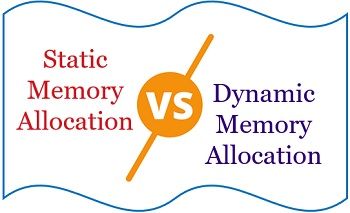 Static and dynamic memory allocation are the two ways of allocating memory to the computer program. The fundamental difference between these two kinds of memory allocation is that the static memory allocation allocates the memory when the programmer compiles the program. The dynamic memory allocation allocates the memory when the programmer executes the program.
Static and dynamic memory allocation are the two ways of allocating memory to the computer program. The fundamental difference between these two kinds of memory allocation is that the static memory allocation allocates the memory when the programmer compiles the program. The dynamic memory allocation allocates the memory when the programmer executes the program.
What is Memory Allocation?
Memory allocation is the task of allocating the memory address to the program (instruction and data). Although the memory allocation is a hardware operation, the operating system controls the task of allocating address space.
Why do we Need Memory Allocation?
Memory allocation is a mandatory process required for the execution of a program. So, if you want to execute a program, it must be first placed in the computer’s memory from where the processor can read and execute it.
Content: Static Vs Dynamic Memory Allocation
- Comparison Chart
- What is Static Memory Allocation?
- What is Dynamic Memory Allocation?
- Key Differences
- Conclusion
Comparison Chart
| Basis for Comparison | Static Memory Allocation | Dynamic Memory Allocation |
|---|---|---|
| Fundamental | It allocates memory to variables when the program is compiled. | It allocates memory to variables when the program is executed. |
| Duration | The allocated memory location remains static throughout the duration of the program. | The allocated memory location can be released at any time during the program duration. |
| Execution Speed | Static memory allocation leverages the speed of execution. | Dynamic memory allocation slows down the execution speed. |
| Allocation | The memory is allocated from the stack. | The memory is allocated from the heap. |
| Changes | Once the memory is allocated, it can not be resized. | The size of allocated memory space can be resized. |
| Complexity | The process is simple. | The process is complex. |
| Efficiency | It is less efficient. | It is more efficient. |
| Example | It is used for allocating memory to an array. | It is used for allocating memory to linked lists. |
What is Static Memory Allocation?
Static memory allocation is a technique where the computer assigns memory to the program during its compilation. Memory once assigned can not vary in size, i.e. you can not increase or decrease the allocated memory size.
Once assigned to the program, the static memory remains throughout the program, i.e. from the moment the program is compiled upto the moment the program completes its execution. After the program executes completely, the memory is deallocated, and it can be allocated to some other entity. This technique allocates the memory to the program from the stack storage.
In static memory allocation, the program executes faster because the memory is assigned to the program before its execution. But it is quite difficult to determine how much memory would be required to run the program, and hence most of the time, memory allocation decisions are to be taken at the run time.
What is Dynamic Memory Allocation?
In dynamic memory allocation, the memory is allocated at the run time, i.e. when the programmer executes the program—this technique assigns the memory from the heap storage.
The memory allocated dynamically can be deallocated at any moment during the program execution. Even the memory allocated can be resized, i.e. you can increase or decrease the memory size. This method is more efficient as it provides the memory space according to the program’s needs.
As the memory is alloted at the run time, this makes an execution a little slower when compared to static memory allocation. The functions used to allocate and deallocate the memory dynamically are calloc(), realloc(), and free().
Key Differences Between Static and Dynamic Memory Allocation
- The most elementary difference between static and dynamic memory allocation is that the static memory is allocated at the time when the program is compiled. However, the dynamic memory is allocated at the time when the program is executed, i.e. at run time.
- The memory allocated by static allocation remains static throughout the program, i.e. from the time it is compiled until its execution. On the other hand, the memory allocated by dynamic allocation can be allocated and deallocated at any time during the program execution.
- In static memory allocation, the memory is already allocated at compile time. Thus, it reduces the run time and makes execution faster. However, the memory is allocated during execution in dynamic memory allocation, making execution slower than static memory allocation.
- The static memory allocation is allocated from the stack whereas, in dynamic memory allocation, memory is allocated from the heap.
- Once the memory is allocated to an entity statically, the memory size cannot be reduced or increased. Instead, in dynamic memory allocation, we can increase or decrease the memory size of an entity.
- Allocating memory statically is a simple process. However, allocating memory dynamically is a complex process.
- Comparatively, the dynamic memory allocation is more efficient than static memory allocation because, in dynamic memory allocation, we don’t need to know how much amount of space will be required by the program beforehand.
Conclusion
We have learned two kinds of memory allocation techniques, i.e. static and dynamic memory allocation. Static memory allocation occurs when the program is compiled; however, the dynamic memory allocation takes place when the program is executed.
However, dynamic memory allocation is preferred over static memory allocation because it is impossible to determine the accurate memory required for a program to execute.
Leave a Reply